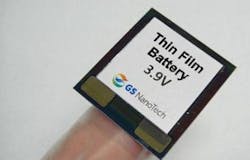Market for flat thin-film and printed batteries to grow to $1.1 billion by 2022
The flat batteries market will grow from $34 million this year to $183 million in 2018, and finally to $1.1 billion by 2022, driven by smart cards, packaging, consumer electronics, wearable devices, and the Internet-of-Things, n-tech analysts say.
Company analysts outline their predictions in a report entitled "Thin-Film and Printed Batteries Markets 2015-2022." This report examines the latest developments in thin-film and printed battery technologies, from materials and design to manufacturing.
Despite these optimistic prospects for growth, the thin-film and printed battery market has not come close to earlier projections. NanoMarkets, the precursor to n-tech Research, predicted seven years ago that thin-film and printed battery technology would represent a $5.6 billion market today, while it actually remains at $34 million.
Related: Thin-film and printed battery market to reach $5.6 billion by 2015
The most recent report looks at the supplier landscape, how it continues to change, evaluates end markets, and provides eight-year forecasts for volumes and revenues.
Among the companies discussed in this report: Apple, Applied Materials, Blue Spark, EnerMat Technologies, Enfucell, FlexEl, Front Edge Technology, Google, Guangzhou Fullriver, Guangzhou Markyn Battery, Imprint Energy, LG Chem, Nokia, Prologium, Rocket Electric, Sakti3, Samsung, Seeo, Solicore, SolidEnergy, STMicroelectronics, Thin Film Electronics, Toes Opto-Mechatronics, and Ulvac.
Wearable electronic devices offer great promise for thin batteries, analysts say. Among the technology drivers will be sensors in Internet of Things devices, which today are too big, too expensive, and limited in functionality, analysts say.
Other technology drivers in thin-film and printed batteries will be powered smart cards, as well as smart labels and packaging. For more information contact n-tech Research online at http://ntechresearch.com.
